Let's be blunt: the US Government collected the closest progenitor to SARS2
In 2017 from a bat cave outside of China
If you have been infected with SARS2, your human body has Covid antibodies to a bat virus found in a remote Laos bat cave. An obscure US government agency collected those bat samples in 2017, and it’s probably the craziest story about the origin of SARS2.
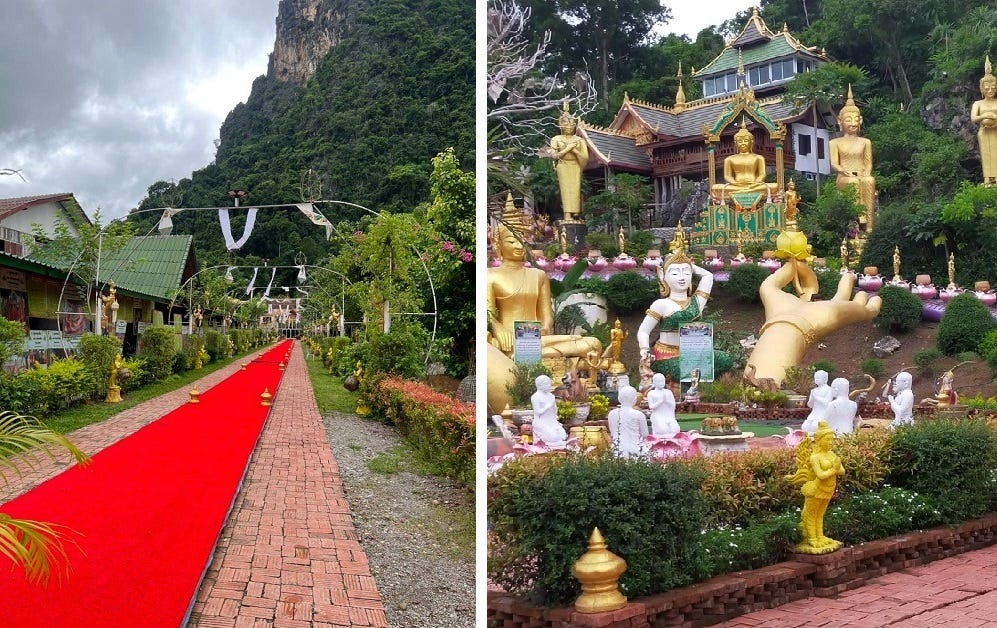
When US-funded scientists collect foreign bat samples, they hire locals to set up ‘harp traps’ to collect the bats as they leave their caves at night. These UC Davis scientists, funded by NIAID’s CREID project, showed us how this works.
They collect bat blood and bat feces samples, which are then shipped back to US labs, such as RML in Montana and UNC in North Carolina.

Montana-based virologists, like Dr Vincent Munster from RML, harvest bat samples from bat caves worldwide. Why? So they can make self-spreading bat vaccines and ‘countermeasures’ against these foreign pathogens. They are trying to ‘preempt’ spillover events into the human population. Munster was also the $9M winner of the 2018 DARPA Preempt project.
The RML Ebola project in Africa stored “the night's crop of samples in liquid nitrogen. Because shipping material that might contain the Ebola virus is a bureaucratic nightmare, the samples might not arrive in the United States for months.” Once the samples arrive in the US, they will be split, with one part tested for Ebola RNA in Munster's Montana laboratory. If it proves positive, the researchers will mix another portion of the sample with cultured bat and monkey cells to test for active virus. "You just add a bit from that sample to your cells and wait [to see] whether you get virus replication," Munster says.
From 2018-20, Munster's lab had so many coronavirus samples that his postdoc had to devise a novel way to organize them. They were ready to publish their results (including RaTG13?) in December 2019, but a Wuhan lab leak got in the way! Both Munster and his postdoc somehow missed the SARS2 furin cleavage site in their Jan 2020 paper but privately mentioned its existence to reporters.
China vs Laos
Up until 2021, the closest bat sample to SARS2 was collected by Dr Shi Zhengli of the Wuhan Institute of Virology. It was called RaTG13 and used NIAID funding for collection in 2013 from the Mojiang mineshaft. This manmade bat cave was located about 1,000 miles southwest of Wuhan and 125 miles north of the Laos border. This Chinese bat sample was the closest to SARS2 (96.1%) and logically made Shi suspect #1 in a Wuhan lab leak scenario.
USAID Predict, another US government agency that funded the collection of bat samples, was within a few miles of the Chinese Mojiang miners who fell ill in April 2012.
USAID Predict (renamed “DEEP VZN”) was quietly canceled in 2023. US government officials gave a “non-denial” about what funding was available.
What happened to the 2017 Laos bat samples?
In February 2017, a US Navy group from the Naval Medical Research Center-Asia (NMRC-A) visited a lab in Vientiane, Laos, managed by an American expat.
NMRC-A is a United States Department of Defense (DoD) biomedical command that promotes U.S. diplomacy in Southeast Asia by conducting basic and applied research, disease surveillance, and outbreak response assistance for infectious diseases of public health importance to the DoD and our regional partners. NMRC-A is one of six biomedical research laboratories outside the continental United States…
The United States Navy has conducted research on neglected tropical diseases in Asia since World War II when NAMRU-2 was first established in Guam under the Rockefeller Foundation. The command was first based in Taipei, Taiwan (1955), and then moved to Jakarta, Indonesia (1970), and then Pearl Harbor, Hawaii (2010). NMRC-A was re-established March 2013 in Singapore under a cooperative research initiative.
NMRC-A funded a Laos bat expedition to collect bat samples of local bats. The 2017 collection site was 165 miles south of the Chinese border along the Mekong River. Nothing was published from this bat expedition besides some bat fly research. No bats, samples, or sequences were ever made public from this publicly funded project.
The Department of Defense (GEIS) now “owns the largest repository of disease” in the world.
If you thought there were a lot of Western scientists in Wuhan, there were even more in Laos, including WIV critic Dr Robert Redfield.
A DARPA connection?

The Riddler of Wuhan lab leak clues were found in Laos
In a plot twist worthy of a Thomas Hardy novel, a more mysterious bat cave emerged well after the SARS2 outbreak. It was along that same Mekong River delta, some 325 miles south of the RaTG13 Mojiang mine and 165 miles deep in the jungles of Laos.
In 2017, the Laos-funded researchers never published the Laos bat samples. The project sponsor (NMRC-A) allegedly did not approve of the researchers sequencing the samples, so they were embargoed in a Laos freezer.


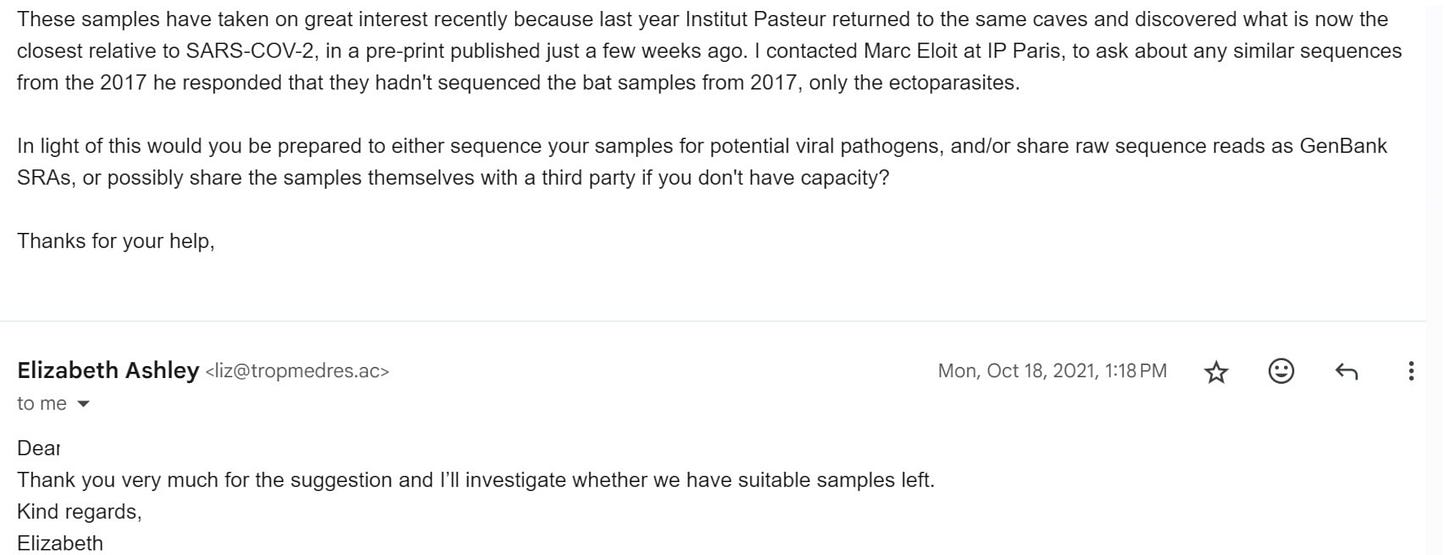
There is no documentation of where the 2017 bat samples went, but it is safe to assume they were shipped to a US lab and kept in a DoD database.
After the SARS2 outbreak, the same Laos researchers, led by the same American expat, returned to the exact same Laos bat cave. But unlike in 2017, they returned without the NMRC-A funding. In 2020, they collected a similar number of bat samples from the same bat species, but this time, they published them in September 2021. The results were the closest match yet.
One of the Laos bat samples (Banal-52 from Malayan horseshoe bats) was a 96.8% match to SARS2. Even closer than the infamous RaTG13 sample (96.1%) collected by Shi in 2013. Most importantly, the Laos Banal-52 sample was a 100% match to the SARS2 receptor binding domain. No similar SARS2 receptor binding domain has been found in Chinese bats or any Chinese animal.
Bob Garry, of Proximal Origins fame, best described Banal-52's relevance. However, he left out the US Government collection history and called it “essentially SARS-CoV-2 minus the furin cleavage site.”
The 2017 Laos bat expedition had nothing to do with the Wuhan Institute of Virology or EcoHealth. Neither the WIV, EcoHealth, or Metabiota came within 150 miles of the Laos Banal site. But Peter Daszak was fond of saying, “Bats don’t have passports,” so scientists can collect foreign bats in hostile territory (China?) from neighboring countries (Laos?)
If the WIV had collected the Laos Banal samples, why not publish them instead of the Mojiang mine headache called RaTG13? Notwithstanding the separate question of why Shi even published RaTG13 in Jan 2020!
A bizarre conspiracy emerged from a British author trying to sell his dated Wuhan lab leak book, claiming the WIV had access to these Laos samples. As if the Pentagon would send Chinese researchers their Laos bat ‘loot’. But Dani of BSL4 fame provides a logical path from Laos to Wuhan via UNC and RML.
2025 Update: In May 2020, Daszak and Linfa Wang bid on a NIAID grant for bat sample collection in Laos. They were awarded the $3M R01AI163118 grant in 2023. This was the 3rd grant of 3 to fund Daszak’s DARPA Defuse project.
The same US Gov entity that funded Laos also funded Duke-NUS
The US Military agency that collected the Laos bat samples worked directly with Dr Linfa Wang and Dr Danielle Anderson at Duke-NUS in Singapore.
NMRC-A researchers, in collaboration with Duke National University Singapore (Duke – NUS), trained local staff in the molecular techniques using algorithms developed for evidence in nasopharyngeal samples of human adenovirus, influenza viruses, enteroviruses and coronavirus infections…
Specimens collected will be isolated, sequenced and studied by collaborators in Singapore in an effort to detect emerging strains of viruses prone to transmission from a zoonotic origin.
The NMRC-A office is located just 10 minutes from the Duke Singapore lab:
The U.S. Naval Medical Research Unit No. 2 (NAMRU-2) concluded its Biannual Science Summit with a retreat hosted by the Programme in Emerging Infectious Diseases (EID) at the Duke-National University of Singapore (NUS) Medical School.
The retreat held in (2018) was led by EID's Professor Linfa Wang. EID partners with groups like NAMRU-2, local hospitals, government laboratories and biotech firms to develop new and effective methods for the treatment, prevention and control of novel and emerging pathogens.
Per Linfa, Southeast Asia has a higher bat diversity than China. This Singapore-based US agency funded Linfa and his Bat Pack in 2012 and 2019. They studied anti-aging and cancer using bat biology. Two recent Duke papers were funded by the U.S. Navy, Office of Naval Research:
“The findings of this study are of significant relevance to Asia-Pacific regional public health laboratories due to the implications for disease prevention and control.”
“The findings of this study will be of interest to U.S. Department of Defense personnel stationed in the Asia-Pacific region and regional public health laboratories engaged in emerging infectious disease surveillance efforts.”
Duke-NUS was basically a Fort Detrick for the US Government in Asia. It was a biological outpost for studying emerging diseases like SARS and Nipah, as well as the bats that harbor them.
HIV inserts?
Yes, the infamous HIV inserts found in SARS2 are also found in Laos Banal bat samples.
UGGUCGC
Yet, to add more academic intrigue, this Laos Banal-52 sample has the exact same TRS leader sequence (UGGUCGC and thread) found in the exact same spot (start of Orf1ab) as its close cousin, RaTG13.
RaTG13 above and Banal-52 below, search its DNA equivalent.
In 2018, Ralph Baric of the University of North Carolina published the “fascinating” and “unique” UGGUCGC fragment in a live attenuated vaccine paper “for reservoir species, such as bats.” Baric called “UGGUCGC…a unique sequence motif when compared with all known coronavirus genome TRN sequences, greatly reducing and likely eliminating the possibility of recombination.”
Basically, Baric was playing with RaTG13 and/or Banal-52 in 2018, both of which are a unicorn sequence used to build a bat vaccine platform. The same year, UNC also published the unique R/SVAS amino acid sequence of RaTG13 and Laos Banal. Just two years later, R/SVAS appeared as part of the infamous RRAR/SVAS furin cleavage site in SARS2.
In 2018, UNC even published a partial nucleotide sequence of Laos Banal-52.
Many criticized the UNC furin cleavage site connection, claiming it was rat ENaC, but we know SARS2 loves American rats!
A consensus sequence of events leading to Covid
In 2018, Baric proposed “consensus (sequence) candidates” in DARPA Defuse. “We will test and validate viral diversity predictions using data from >10,000 previously collected bat samples from six Asian countries (NIAID and USAID PREDICT funded)” for predictive modeling “in caves across Asia” to “reduce SARSr-CoV shedding in cave bats.”
Baric wanted an average of SARS-like bat strains along the Mekong River delta in Southeast Asia. The idea was to box in (i.e., bookend) the future evolution of a “pandemic potential” pathogen.
There is only one freezer that is more interesting than Laos, and it’s in Chapel Hill. Baric said, “Several coronavirus infectious cDNA clones are available in (his) lab, including SARS-CoV, MERS-CoV, conventional human and model CoVs, and several bat CoVs with pandemic potential.” One virologist said, “I would be afraid to look in their freezers.”
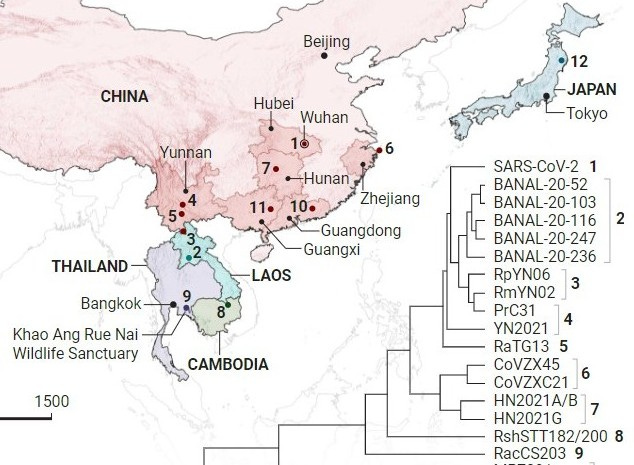
He used this collection to create a consensus sequence (now called SARS2) using RaTG13, Banal-52, RmYN02 collected in 2019, RShSTT182 from Cambodia (but collected in 2010 with USAID Predict funds) and RacCS203 from Thailand (via Duke-NUS). The academic idea behind a ‘consensus sequence’ was best described by an anonymous WHO collaborator.
"This means that they (Baric “wrote that section”) would take various sequences from similar coronaviruses and create a new sequence that is essentially the average of them. It would be a new virus sequence, not a 100% match to anything.”
The anonymous source said it was noteworthy that the cut-off for generating such an average sequence was viruses that only had 5% genetic divergence from each other.
In 2020, scientists at the Wuhan Institute of Virology said they had found a strain named RaTG13 in bat droppings in a cave in Yunnan province in 2013 which was a 96.1 per cent match to SARS-CoV-2. It means RaTG13 (and Banal-52, etc.) could have been included in a set of viral genomes to help create an average sequence.
The WHO source added: "If SARS-CoV-2 comes from an artificial consensus sequence composed of genomes with more than 95% (i.e. <5% nucleotide variation) similarity to each other… I would predict that we will never find a really good match in nature and just a bunch of close matches across parts of the sequence, which so far is what we are seeing.
In 2017, Baric referenced Linfa’s bat immunology research eight times in his “Jumping Species” paper. He even discussed the importance of a furin cleavage site for a spillover event! That same year, Munster referenced Linfa’s bat immunology research seven times. In 2018, both Baric and Munster experimented with Egyptian fruit bats as a stand-in for Chinese horseshoe bats. In 2019, both Dani and Linfa referenced Baric’s ‘consensus sequence.’ In late 2019, all four of these Covid characters were working on NIAID’s $82M CREID project.

In 2020, the SARS2 sequence from “China” found a new (reservoir) home in US lab animals like Egyptian fruit bats. In 2021, if you were infected (inoculated?) with Covid (a bat vaccine?) you now have antibodies to that Laos Banal bat sample (236), collected by the US Government in 2017. Researchers found that antibodies produced by people during Covid infections were very potent against the Laos Banal bat samples.
DYOR on this crazy biological rabbit hole
2025 update: I linked to original resources above, but DRASTIC’s Billy Bostickson was the first to report the US military GPS connection to the Laos Banal bat samples.
Site 1 in 2017 (map above) is a 14-minute walk to site 1 in 2020 (map below).
In 2020, this Laos bat cave was sampled for the second time using five bat catch nets surrounding the original (unpublished) 2017 location.

Laos Supplementary information
The 2017 Laos GPS coordinates above versus 2020 GPS coordinates below
Laos 2017 bats samples above versus Laos 2020 bats samples below
Entry was blocked by human sera neutralizing SARS-CoV-2, but not by control non-neutralizing sera, demonstrating that neutralization of BANAL-236 was specific for epitopes shared with the spike protein of SARS-CoV-2 (Fig. 4b).
Sera-neutralizing SARS-CoV-2 were from patients with confirmed infections, whereas non-neutralizing sera samples were collected before the spread of SARS-CoV-2 in Laos.










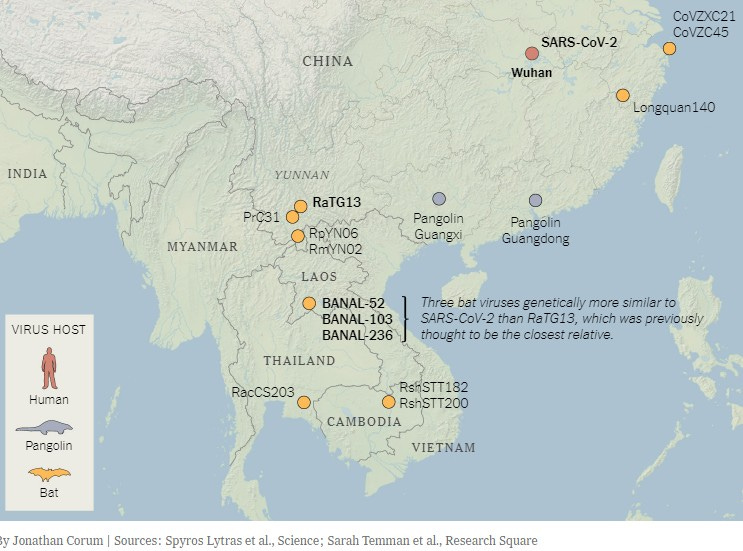

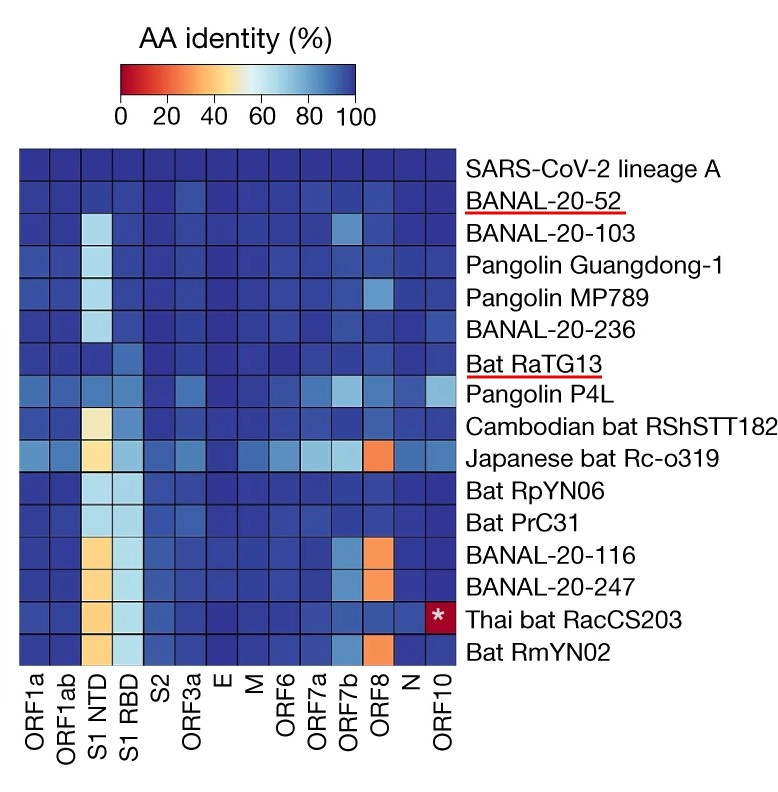
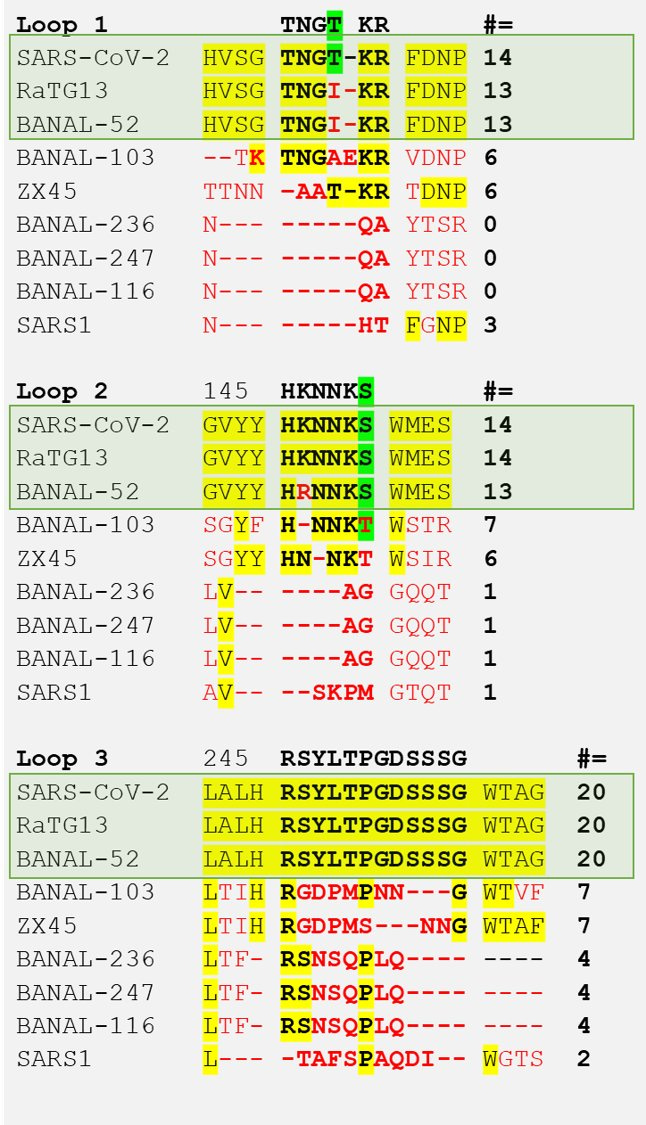






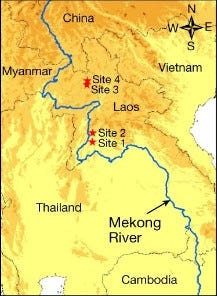
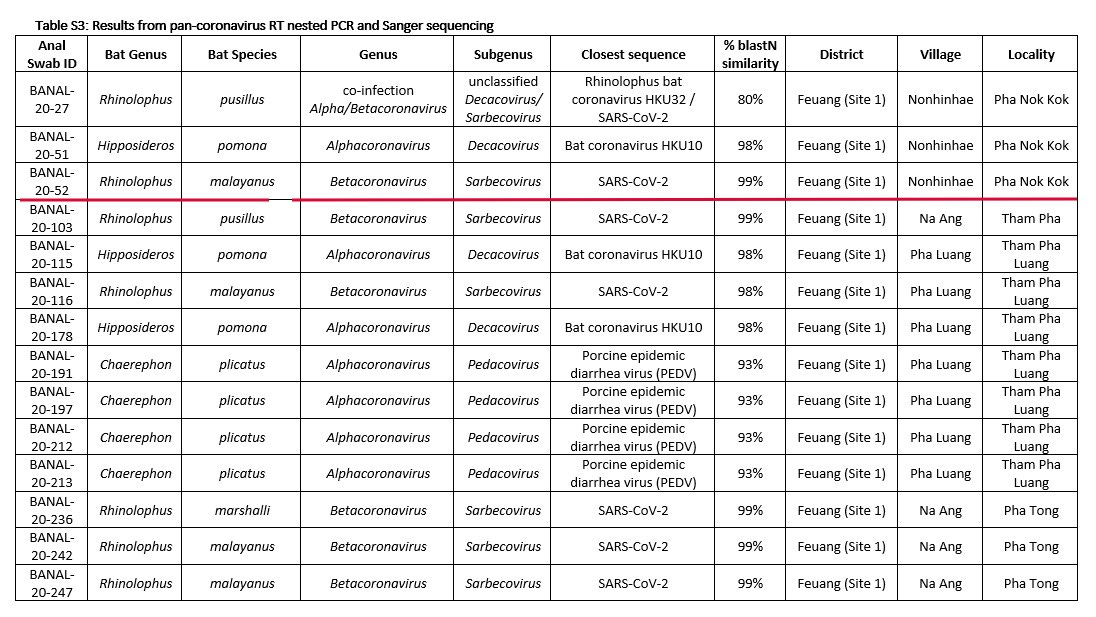

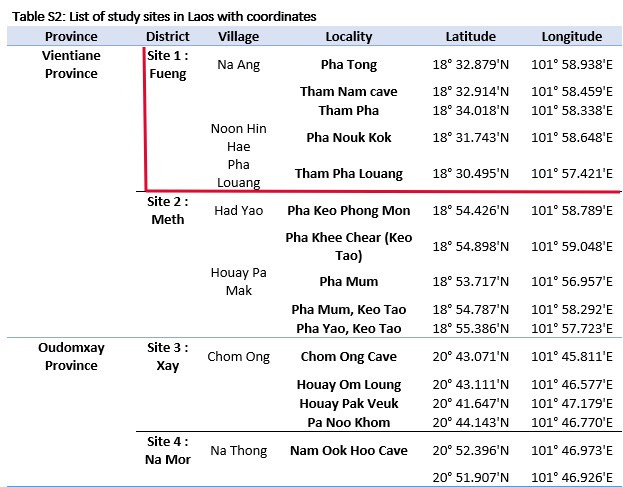
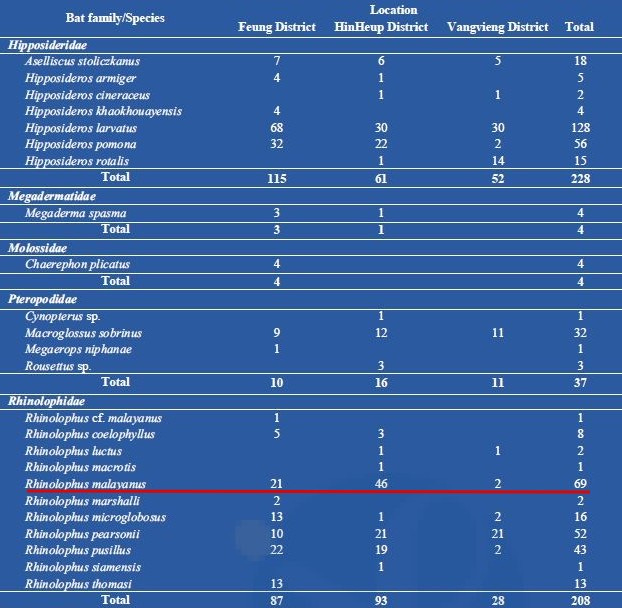
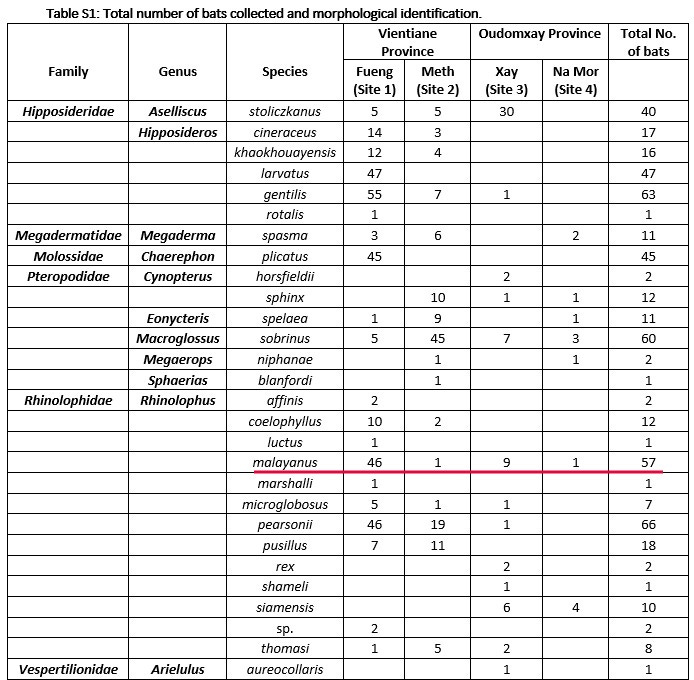

Great work and fascinating analysis!
It would be nice, as you usually do, if you cited my original discovery of the USNAMRU/Pasteur trip to that location:
https://x.com/BillyBostickson/status/1438929425047822339
finding confirmed:
https://x.com/babarlelephant/status/1439238959691878402
and the 2016 PREDICT trip
https://x.com/BillyBostickson/status/1438940242942169094
and maybe the 3 locations map created by @tlitb
https://x.com/BillyBostickson/status/1874047537403039987
Definitely suspicious. Found this report from pasteur but they did not even mention coronaviruses .
https://www.pasteur.la/project-carried-on-in-the-lab-14/assessment-of-the-potential-vector-threat-of-bat-borne-pathogens-and-the-host-associated-ectoparasites-in-the-provinces-of-vientiane-and-khammouane-of-the-lao-pdr-batmap-project-extension/
I suspect the 2021 sequences may hv been from 2017 samples. Unlike RaTG13 they actually isolated the virus (so they say)